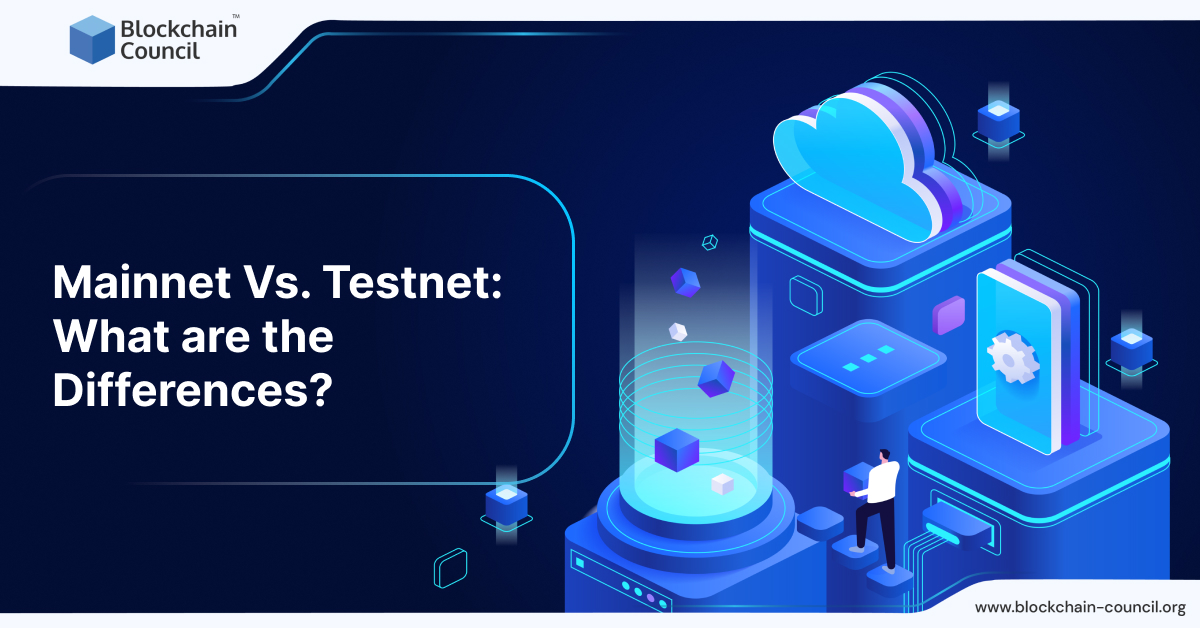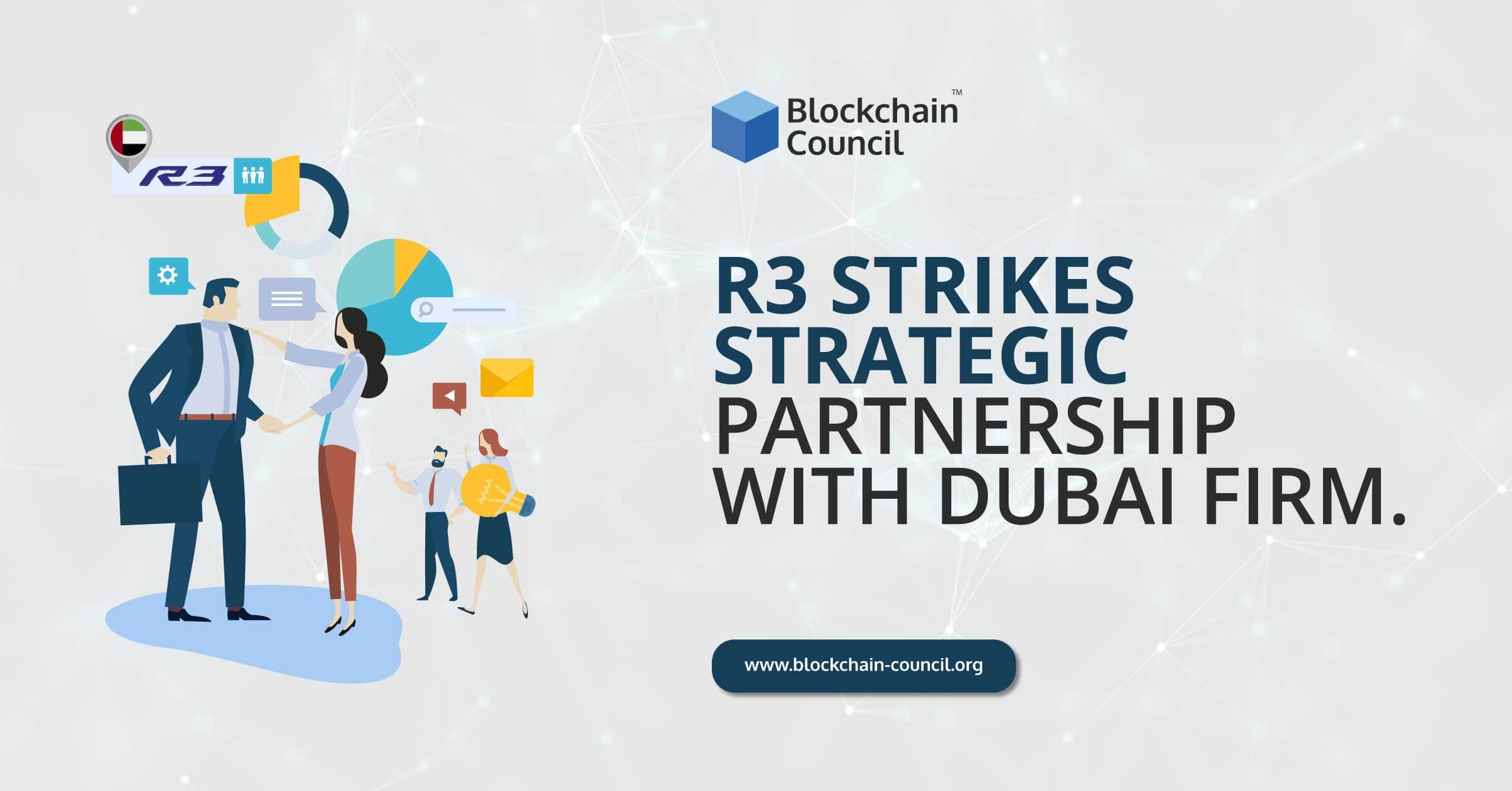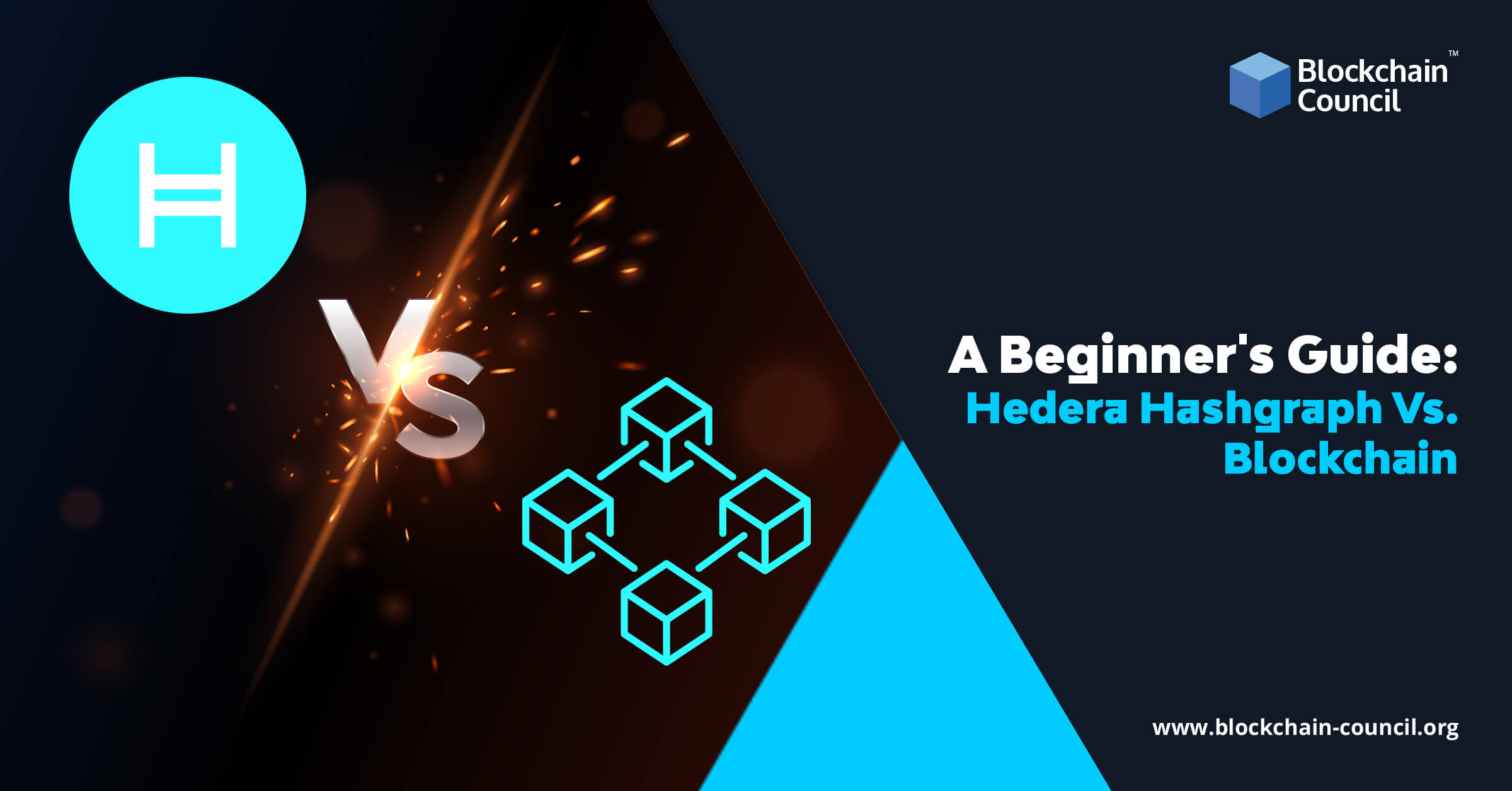
- Blockchain Council
- May 03, 2024
Summary
- Mainnet and Testnet are essential components of Blockchain technology.
- The main difference between Mainnet and Testnet is simple: Mainnet is the live Blockchain network for a specific cryptocurrency, whereas Testnet is a testing phase for new code and features.
- Mainnet is where real transactions happen with actual results, while Testnet is a developer’s playground for risk-free experimentation.
- Miners play a crucial role in the Mainnet by validating transactions and adding them to the Blockchain.
- Mainnet transactions are real and recorded on the Blockchain, ensuring security and trust.
- Testnet is a duplicate of the Mainnet for testing and experimentation.
- Testnet is open to everyone interested in Blockchain technology and provides a controlled environment for innovation.
- Key differences between Mainnet and Testnet include their purposes, cost, network IDs, node numbers, security, and impact on the Blockchain ecosystem.
- Mainnet has real monetary value, while Testnet uses tokens with no monetary value.
- Mainnet and Testnet have distinct technical characteristics, token transferability, consensus mechanisms, and bug bounty programs.
In the dynamic realm of Blockchain technology, understanding the distinction between Mainnet and Testnet is crucial. The main difference between the two is simple. Mainnet is like the real action on a Blockchain, where real transactions happen with real results. On the other hand, Testnet is like a playground for developers to try out and improve their apps without any real risks. Both Mainnet and Testnet help make Blockchain better by connecting ideas and reality.
In this article, we will discuss the key differences between Mainnet and Testnet. We will also explain why they both need to come together for the ultimate success of the Blockchain world. So, let’s dive in!
What is a Mainnet?
A Mainnet is a fully developed and operational Blockchain network that serves as the primary infrastructure for a specific cryptocurrency. Before a Blockchain project reaches the Mainnet stage, it typically goes through a testing phase known as a Testnet. Testnets provide a controlled environment where developers can test new code, fine-tune logic, and experiment without affecting the live Mainnet. Once the code passes quality assurance in the Testnet, it’s migrated to the Mainnet production environment, where it becomes accessible to the public.
When a user initiates a transaction on the Mainnet, the transaction information is broadcast to the network nodes. Miners play a vital role by competing to solve complex mathematical puzzles. The first miner to successfully solve the puzzle and add the transaction to the Blockchain is rewarded with a predetermined amount of cryptocurrency. This incentive system encourages miners to actively participate in the network.
The term “Mainnet” is used to describe a fully developed and deployed Blockchain protocol. On the Mainnet, cryptocurrency transactions are broadcasted, verified, and recorded on a distributed ledger, commonly known as the Blockchain. This is in contrast to Testnets, which serve as experimental environments for developers to troubleshoot and test features.
Mainnets provide users with confidence in the security and transparency of their transactions. Every transaction is recorded, ensuring a high level of trust and security. Mainnets serve as the live network where all transactions and data are processed and recorded, making them the cornerstone of Blockchain technology. This live, fully operational Blockchain network allows users to engage in various activities, from sending and receiving cryptocurrency to developing decentralized applications and creating smart contracts.
Also Read- How Does a Mainnet Work? Explained
What is a Testnet?
A Testnet is a duplicate version of a Blockchain network used for testing and experimentation. It’s like a sandbox where developers can try out new features and updates without risking real funds or affecting the main Blockchain. Testnets are essential for identifying and fixing potential issues before deploying changes to the live network.
Testnets are designed to mimic the Mainnet in almost every aspect. They carry the same features, functionalities, and underlying technology. This replica environment serves as a testing ground for developers. They can implement and experiment with new features, changes, and updates without affecting the actual transactions on the Mainnet. It’s like trying out a new recipe in a controlled environment before serving it to your guests at a dinner party.
One of the remarkable aspects of Testnets is their accessibility. They are open to everyone interested in exploring the world of Blockchain technology. There are no secret handshakes or exclusive invitations required. Whether you’re a seasoned developer or a Blockchain novice, you can join the Testnet by setting up a node or using a wallet. This openness fosters an environment of continuous learning and innovation.
Also Read- How Does zkEVM Work?
Key Differences Between Mainnet and Testnet
When diving into the world of Blockchain, understanding the key distinctions between a Mainnet and a Testnet is essential. So what are the main differences between Mainnet and Testnet? Let’s find out!
| Aspect | Mainnet | Testnet |
| Purpose | Real-world transactions and operations | Developer experimentation and testing |
| Cost and Token Value | Operations require real cryptocurrency | Tokens have no monetary value |
| Network ID and Genesis | Mainnet typically starts with “1” | Testnets often use numbers like “3 or 4” |
| Nodes and Transaction | Large network of nodes, high transaction | Smaller number of nodes, lower frequency |
| Security and Use Cases | High security, real-world assets | Primarily for testing and experimentation |
| Impact Factor | Significant impact on the blockchain | Limited impact on the overall ecosystem |
| Technical Characteristics | Fully operational, robust infrastructure | Scaled-down network for experimentation |
| Token Transfer | Tokens not transferable between the two | Assets from Testnet can be moved to Mainnet |
| Consensus Mechanisms | Proof of Work (PoW) and Proof of Stake (PoS) | Focus on testing protocol upgrades |
| Developer Feedback | Bug bounties for security on the Mainnet | Smaller scale bug bounty programs on Testnet |
Purpose Matters
At the core, the purpose sets the stage. Mainnet is where real-world transactions and operations occur, where you execute contracts, transact with cryptocurrencies, and deploy decentralized applications (dApps). It’s the live, operational version of the Blockchain, a world of real value.
On the flip side, Testnet serves as the playground for developers, offering a risk-free environment to experiment. It’s where innovation meets caution. Here, developers explore, test new features, and tinker with smart contracts without risking real assets. It’s a realm of potential, free from real-world consequences.
Cost and Token Value
In the world of Blockchain, cost is a critical factor. In the Mainnet, every operation comes with a price, as tokens hold tangible value. From transfers of value to staking rewards and smart contract deployments, each move requires real cryptocurrency.
In contrast, the Testnet operates with tokens that hold no monetary value. Here, experimentation comes free of charge, making it an ideal space for developers to refine their skills and innovations without the cost concerns of the Mainnet.
Network ID and Genesis Blocks
Network identification plays a significant role in distinguishing the two environments. Mainnet typically begins with the number “1,” while Testnets often use numbers like “3 or 4.” These IDs serve as beacons, helping project owners and developers navigate the Blockchain ecosystem.
Furthermore, each Mainnet and Testnet has its own unique Genesis block, marking the beginning of their respective journeys. These blocks set the foundation for their distinct characteristics and functionalities.
Nodes and Transaction Frequency
Nodes, the backbone of a Blockchain network, are fewer in number on a Testnet compared to the Mainnet. While the Mainnet boasts a vast network of nodes working tirelessly to validate and process transactions, the Testnet takes a more modest approach.
Transaction frequency follows suit, with the Mainnet experiencing a high volume of transactions as users engage in real economic activities. On the other hand, Testnets record a lower transaction frequency, reflecting their nature as experimentation grounds.
Security and Use Cases
Mainnet’s security is paramount. With real value at stake, it employs encryption, multi-sig transactions, and smart contract audits to ensure the safety of transactions and user assets. It’s where real-world assets are stored and real value is exchanged.
Testnets, while useful for experimentation, have a more limited scope. They primarily cater to testing trading, DApp development, and smart contracts. Developers use Testnets to evaluate the impact of changes and ensure they function as intended before migrating to the Mainnet.
The Impact Factor
Ultimately, Mainnet holds a more significant impact on the Blockchain landscape. It’s where the rubber meets the road, where real-world transactions shape the ecosystem. Any alteration on the Mainnet can affect users’ funds and the Blockchain’s functionality.
Technical Characteristics
The technical aspects of Mainnet and Testnet play a pivotal role in their differentiation. Mainnet is the fully operational Blockchain network, characterized by its robust and extensive infrastructure. It consists of a large number of nodes that validate and process transactions, ensuring the integrity and consistency of the ledger. Smart contracts deployed on the Mainnet interact with the Blockchain, executing predefined code based on user inputs or triggered events.
On the other hand, Testnets, while similar in functionality, typically feature a smaller number of nodes. This scaled-down network serves as a simulated environment where tokens used for transactions hold no real-world value. This allows developers to experiment freely without incurring financial risks. Testnets often include unique features such as faucets, which distribute test tokens to users for testing purposes.
Token Transfer
A critical distinction lies in the transferability of assets between Mainnet and Testnet. Due to their separate existence, tokens cannot be seamlessly transferred between the two environments. Attempting to send real tokens to a Testnet address results in the loss of those tokens, as they have no value in that context. Similarly, Testnet tokens cannot be sent to the Mainnet, where they hold real-world value.
However, assets developed on a Testnet, such as decentralized applications (DApps), can be transferred to the Mainnet. This process involves deploying the tested product onto the actual Blockchain, expanding its utility and impact.
Consensus Mechanisms
Security is a critical aspect of the Blockchain world. Mainnet employs various consensus mechanisms to secure the network, with two primary methods being Proof of Work (PoW) and Proof of Stake (PoS). PoW involves miners solving complex mathematical problems to validate transactions, while PoS relies on validators who stake a proportionate amount of tokens as collateral.
Testnets also focus on security but operate in a more controlled environment. They allow developers to test protocol upgrades, hard forks, and other changes to the Blockchain network. This testing phase ensures stability and compatibility before these changes are implemented on the Mainnet.
Developer Feedback and Bug Bounties
On the Mainnet, established Blockchain projects often offer bug bounties to white hat hackers and developers who can help identify vulnerabilities or potential threats. These bug bounties are critical for maintaining the security and reliability of the Mainnet. In contrast, Testnets are more focused on the development phase, and while security is essential, the scope and scale of bug bounty programs are often smaller.
Also Read- What is zkEVM?
Conclusion
The juxtaposition of Mainnet and Testnet unveils a compelling narrative of safety, innovation, and real-world application. Mainnet is where Blockchain ideas become real solutions, and Testnet is where these ideas are tested and improved. They work together to develop Blockchain technology in a practical way. Understanding Mainnet and Testnet helps you navigate the world of Blockchain and move towards a future with dependable digital solutions.
While this article explained the key differences between Mainnet and Testnet, it is important to keep yourself updated to thrive in the Blockchain world. Consider the Blockchain certifications by the Blockchain Council to upskill yourself and be the most-sought after Blockchain professional!
FAQs
What is the difference between Mainnet and Testnet?
- Mainnet is the live Blockchain network where real transactions and operations occur, while Testnet is a duplicate version of the Blockchain used for testing and experimentation.
- Mainnet involves real cryptocurrency transactions with tangible value, whereas Testnet uses tokens with no monetary value.
- Mainnet is where smart contracts are executed and real-world assets are stored, while Testnet is a risk-free environment for developers to experiment and innovate.
What is Mainnet?
- Mainnet is a fully developed and operational Blockchain network that serves as the primary infrastructure for a specific cryptocurrency.
- It is the live, real-world version of the Blockchain where transactions are executed, smart contracts are deployed, and real value is exchanged.
What is Testnet?
- Testnet is a duplicate version of a Blockchain network used for testing and experimentation.
- It mimics the Mainnet in functionality and features but operates with tokens that hold no monetary value, making it a safe environment for developers to experiment.
Is Testnet safe to use?
- Yes, Testnet is safe to use for testing and experimentation.
- Transactions on Testnet have no real monetary value, so there is no risk of losing actual assets.
- It provides a controlled and risk-free environment for developers to refine their skills and test new features without cost concerns.





































































 Guides
Guides News
News Blockchain
Blockchain Cryptocurrency
& Digital Assets
Cryptocurrency
& Digital Assets Web3
Web3 Metaverse & NFTs
Metaverse & NFTs
